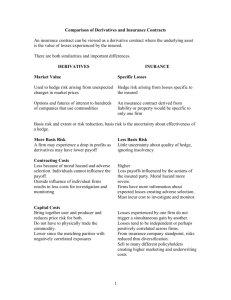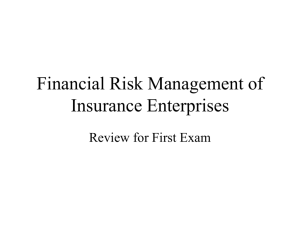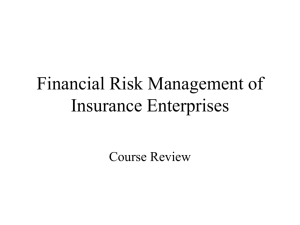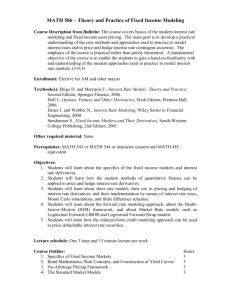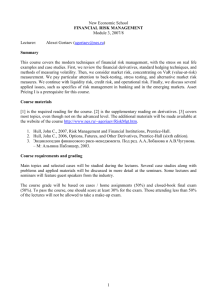Introduction
advertisement
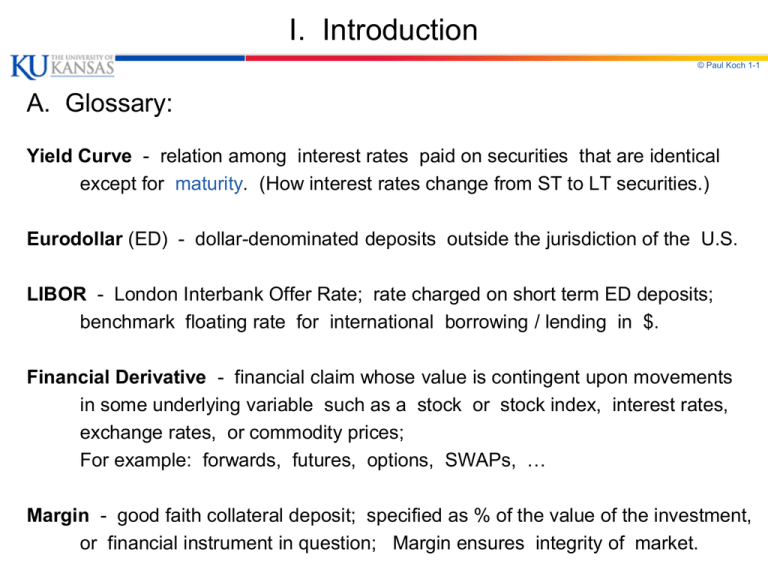
I. Introduction © Paul Koch 1-1 A. Glossary: Yield Curve - relation among interest rates paid on securities that are identical except for maturity. (How interest rates change from ST to LT securities.) Eurodollar (ED) - dollar-denominated deposits outside the jurisdiction of the U.S. LIBOR - London Interbank Offer Rate; rate charged on short term ED deposits; benchmark floating rate for international borrowing / lending in $. Financial Derivative - financial claim whose value is contingent upon movements in some underlying variable such as a stock or stock index, interest rates, exchange rates, or commodity prices; For example: forwards, futures, options, SWAPs, … Margin - good faith collateral deposit; specified as % of the value of the investment, or financial instrument in question; Margin ensures integrity of market. I.A. Glossary, continued © Paul Koch 1-2 Organized Exchange - centralized location where organized trading is conducted in certain financial instruments under a specific set of rules. The exchange clearinghouse is the counter-party to every transaction; members of the exchange share the responsibility of fulfilling commitments. The exchange: (i) Sets standardized terms for all contracts traded, (ii) Often places restrictions on trading (e.g., margin, price limits, ...). (iii) Standardization of contracts and other rules make clearing easier, reduce uncertainty about counterparty default risk, and help ensure an orderly market. Over-the-Counter (OTC) Market - any market where transaction takes place other than an organized exchange; e.g., thru financial institution or broker. Arbitrage Portfolio - (i) uses none of your own money; (ii) has no risk. I.A. Glossary, continued © Paul Koch 1-3 Debt Instrument, Bond - Prior, fixed claim against earnings & assets of firm. Equity Instrument, Stock - Residual ownership claim against earnings & assets. Forward Contract - commitment by two parties to exchange a particular good for a specific price (F) at a specified future time (Expiration, Maturity); No cash exchanges hands initially; At expiration cash exchanged for the consideration specified in the contract; Traded OTC; Customer typically required to post margin. Futures Contract - same as Forward, except profits / losses are computed and settled (marked-to-market) on a daily basis rather than only at maturity; typically traded on organized exchange. Financial Futures - futures contract in which the good to be delivered is a financial instrument. II. Corporate Uses of Derivatives © Paul Koch 1-4 Survey of Managers of Fortune 500 Companies. A. Why do firms use derivatives? 1. Hedge Transaction Exposure. (Cost / Rev = P x Q; Q fixed) 2. Hedge Economic Exposure. (Cost / Rev = P x Q; neither fixed) 3. Reduce Funding Costs. (Reduce risk; lower cost of capital) 4. Trade for Profit. (Speculate; take risks with deriv.’s) B. What derivatives? 1. To manage foreign exchange exposure, Use OTC forwards, SWAPs, & options, then exchange-traded futures & options. 2. To manage interest rate exposure, Use OTC SWAPs, options (e.g., caps, floors, ... ), then exchange-traded futures & options. II. Corporate Uses of Derivatives © Paul Koch 1-5 C. What keeps managers from using derivatives more? 1. Counterparty Credit Risk. (AIG, Lehman Bros, Enron, …) 2. Lack of knowledge / expertise. (Need is greater at small firms.) D. Who are derivatives users? 1. Corporations, Financial Institutions. (Want to hedge or take risk.) 2. Dealers: commercial banks, investment banks. a. Function as intermediary or broker providing OTC risk management products. b. Face following risks: (i) Credit Risk; (ii) Market Risk; (iii) Legal Risk; ☼☼☼→ (iv) Operating Risk. (Counterparty default) (Prices may change, gain / loss) (Enforcement of contracts) (Internal controls) ←☼☼☼ II. Corporate Uses of Derivatives © Paul Koch 1-6 E. Increasing pressure to hedge. 1. Fear of litigation; ‘duty’ to hedge? Tort reform: what is firm’s ‘duty’? F. Regulators have expressed concern. 1. SEC, CFTC, Comptroller, Fed, FDIC, ... (Response to disasters.) G. Courts have questioned enforceability. 1. Ultra vires - 'beyond power' a. When a counterparty is legally incapable of entering contract. b. 1991, U.K. House of Lords ruled a London borough didn't have to pay bank big losses on interest rate SWAPs ... 2. OTC derivatives may be 'illegal futures.' a. U.S. Commodity Exchange Act (CEA); 1980s & 90s, confusion. H. How should firms manage their use of derivatives? 1. Group of 30 Good Practice Recommendations. Operating Risk Mgt. III. The Role of the Board of Directors (G-30) © Paul Koch 1-7 A. Review and Approve Risk Management Policies. 1. Make clear what risk the firm wishes to manage: a. Volatility of earnings. b. Volatility of value of the firm (market cap). c. Volatility of cash flows. 2. Make clear what derivatives the firm wishes to use, 3. Make clear how the firm wishes to use these instruments. B. Ensure Capability. 1. Make sure senior management verify that firm has expertise; that training and software capabilities are up to task. 2. Make sure people & software are capable of measuring and monitoring risk exposures. III. The Role of the Board of Directors (G-30) © Paul Koch 1-8 C. Evaluate Performance. 1. Measure & monitor what the firm wishes to manage: a. Volatility of earnings. b. Volatility of value of the firm (market cap). c. Volatility of cash flows. D. Implement Group of 30 Good Practice Recommendations. G-30 Recommendation 1: Summarizes A - C above, & elaborates. Dealers and users should use derivatives in a manner consistent with the overall risk management and capital policies approved by their boards of directors. These policies should be reviewed as circumstances change. Policies governing the use of derivatives should be clearly defined; the purposes of these transactions, who is authorized to trade, … IV. Derivatives Disasters (Hull, Chap 25) © Paul Koch 1-9 A. Big Losses by Financial Institutions Allied Irish Bank ($700 million) Amaranth (6 billion) Barings ($1 billion) Enron’s counterparties (billions) Kidder Peabody ($350 million) LTCM ($4 billion) Midland Bank ($500 million) Société Générale ($7 billion) Subprime mortgages (tens of billions) UBS ($2.3 billion) JP Morgan ($4 billion) IV. Derivatives Disasters © Paul Koch 1-10 B. Big Losses by Non-Financial Corporations Allied Lyons ($150 million) Gibsons Greetings ($20 million) Hammersmith and Fulham ($600 million) Metallgesellschaft ($1.8 billion) Orange County ($2 billion) Procter and Gamble ($90 million) Shell ($1 billion) Sumitomo ($2 billion) Sem Group ($3 billion) Many more … See folder of WSJ articles on BB. IV. Derivatives Disasters © Paul Koch 1-11 C. Lessons for All Users of Derivatives Risk must be quantified and risk limits set Exceeding risk limits without authority is not acceptable, even when profits result Do not assume that a trader with a good track record will always be right Be diversified Conduct scenario analysis and stress testing IV. Derivatives Disasters © Paul Koch 1-12 D. Lessons for Financial Institutions Monitor traders carefully Separate the front, middle, and back office Models can be wrong Be conservative in recognizing profits Do not sell clients inappropriate products Beware of easy profits Liquidity risk is important IV. Derivatives Disasters © Paul Koch 1-13 E. More Lessons for Financial Institutions There are dangers when many are following same strategy Do not make excessive use of short-term funding to meet long-term needs Market transparency is important Manage incentives Never ignore risk management, even when times are good IV. Derivatives Disasters © Paul Koch 1-14 F. Lessons for Non-Financial Institutions It is important to fully understand the products you work with Beware of activities designed to hedge turning into speculation It can be dangerous to make the Treasurer’s department a profit center V. Accounting © Paul Koch 1-15 A. Problems presented by derivatives. 1. How & when to recognize transactions. 2. How & when to recognize value changes. 3. How to regard different claims (e.g., Debt or Equity?). 4. Point: Many derivatives used to remain unrecognized, while others were recognized & measured, some at market value, others based on past prices. 5. In 2000, FAS #133 was implemented (revision of FAS #52 & #80): a. Derivatives gains / losses booked as earnings unless bona fide hedge. Then deriv. gains / losses matched against losses / gains over the life. B. Hedge Accounting. 1. Set of rules to recognize changes in values of components of hedge so that counterbalancing changes in fair values of hedged items and hedging instruments are included in earnings in same period. V. Accounting © Paul Koch 1-16 C. Taxation. 1. Issue: whether gains / losses on hedge will be treated as ‘ordinary income’ or ‘capital gains / losses’ for taxes. a. Boils down to asymmetric tax treatment. 2. History of inconsistent treatments. 3. Current policy (FAS #133): Gains / losses on derivatives are treated as ordinary income for tax purposes, if it can be shown that purpose is truly to hedge; Otherwise, treated as capital gains / losses. These gains / losses on the hedging asset (the derivative) may be matched against losses / gains on the asset being hedged, and amortized over the life of the hedge. V. How Risk Management Can Add Value © Paul Koch 1-17 Value of firm j = Vj = Σ E(NCFjt) / (1 + rjt )t . Vj will increase only if: (i) rjt ; (ii) E(NCFjt) . A. Impact of risk management on rjt . 1. Risk management will decrease volatility of Vj . a. This should decrease the firm’s beta; b. This should decrease probability of default. 2. Both 1.a & 1.b should make investors willing to pay more for the firm’s debt and equity. This should reduce the firm’s cost of capital (rjt). V. How Risk Management Can Add Value © Paul Koch 1-18 B. Impact of risk management on E(NCFjt). 1. Risk Management can add value by decreasing taxes. a. Hedging reduces probability that income will be too low to take advantage of tax shields. b. Derivatives allow firm to obtain accrual (hedge) accounting tax treatment for risk management. c. Derivatives can be used to take advantage of asymmetries in tax treatment (e.g., across borders). 2. Risk Management can add value by decreasing transaction costs. a. Firms can adjust exposure by selling some assets and buying others, or by trading derivatives; derivatives cheaper. b. Risk management reduces the expected costs resulting from risk of financial distress. V. How Risk Management Can Add Value © Paul Koch 1-19 3. Risk Management can add value by helping firm to avoid bad investment decisions. a. Firm may turn down positive NPV projects: i. If firm is in financial distress; ii. Due to conflict between shareholders & debtholders. 4. Derivatives can be used to assure debtholders: a. By attaching restrictive covenants to debt; b. By making the debt convertible; c. By issuing preferred stock instead of debt (to reduce probability of future default); d. If risk management reduces probability of default, firm is less likely to turn down good opportunities.

